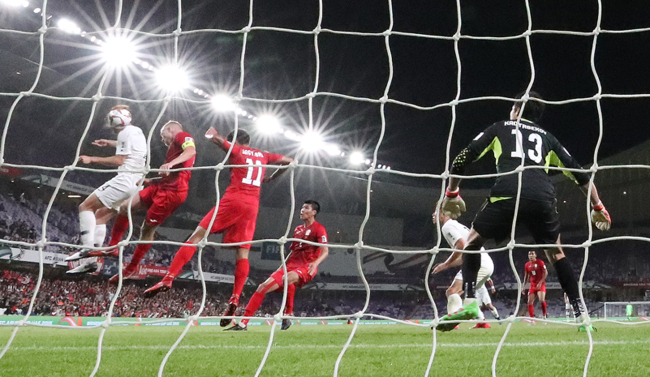No more games on TV: Streaming services replacing TVs in sports broadcasts
Changing viewer trends, easier access boost streaming services’ presence in sports broadcasts; lack of funds, infrastructure remain major barriers
By Yeo Jun-sukPublished : Jan. 14, 2019 - 15:58
When South Korea secured a narrow 1-0 victory over Kyrgyzstan at the Asian Cup Games in the United Arab Emirates on Saturday, Korean soccer fans did not rely on traditional broadcasters to watch the match.
In fact, there were no live broadcasts from the country’s three media giants -- KBS, MBC and SBS. Only JTBC, a cable network owned by a local media group, broadcast Korea’s second match at the Asian Cup.
As more viewers have begun to shift from traditional broadcasters to streaming services for live sports around the world, the scene of people gluing their eyes to TV screens is becoming a thing of the past in South Korea as well.
Kwon Jong-hyuck, a 35-year-old longtime soccer fan who works at an information technology company in Seoul, said he watched Saturday’s match through the country’s most popular online streaming service, Afreeca TV.
“Neutral voices from professional broadcasters are not what I want,” said Kwon, who enjoyed the game broadcast by popular Afreeca TV streamer Gamst. “I want to feel like I’m at a bar with my friends. Internet streaming services give me such pleasure.”
Territorial broadcasters have often paid skyrocketing prices for the rights to air the World Cup or Olympics --sometimes exclusively -- with pride in their abilities to deliver heated moments without a hitch.
But with sports events becoming less lucrative investments for Korea’s broadcasting giants, their latest absence at Asia’s biggest soccer competition suggests a changing trend in the way people prefer to watch sports, industry watchers say.
Kim Jo-han, a media industry expert at Gom & Co., attributed broadcasters’ shrinking enthusiasm for live broadcasts to changes in Korea’s viewership preferences: People prefer edited online footage over sitting down for an entire live broadcast.
“Spending more than two hours in front of a TV is an awfully long time for young viewers,” said Kim. “Instead of watching the whole game on terrestrial broadcasters, they want to enjoy it with more entertaining content, or just pick up the highlights on internet portals.”
With fewer people watching sports via traditional broadcasters, media companies would be more reluctant to spend a hefty sum on sport games.

Watching Gamst, for example, one feels like part of the banter rather than passively watching a sports forecast, as Gamst wears ridiculous outfits, trades inside jokes with die-hard fans and squabbles with random visitors. Expletives are flung around freely as well.
Instant communication with viewers is one of the most significant features setting online streaming services apart from traditional broadcasters’ homogenous content designed for unknown masses.
“I’m trying to make our viewers feel like they are watching the games with close uncles,” Gamst said in an interview with a local newspaper last week. “I’m glad I have created my own way of broadcasting.”
Easier access through mobile devices is also one of the advantages.
Such efforts to establish their own community have led to massive popularity, with Gamst becoming the most popular streamer on Afreeca TV. His broadcast of the 2018 Russian World Cup attracted the largest number -- 350,000 viewers -- of people watching the game between South Korea and Mexico.

Terrestrial TVs, threatened
With live sports broadcasting having boosted the growth of conventional broadcasters worldwide in the early 1990s, Korea’s media giants have devoted much of their resources to delivering popular sports.
Major events have been a battleground for larger viewership ratings among broadcasters, equipped with massive infrastructure and finances to broadcast international sport events such as the Olympics and World Cup.
The competition has often resulted in hefty prices for the right to broadcast the sport events. For example, KBS, MBC and SBS reportedly paid about 120 billion won ($107 million) to FIFA to broadcast its 2018 Russia World Cup.
“Sport is considered to be a crown jewel of live broadcasting,” research firm Nielsen said in a report in 2017. “We are forced to watch in a fixed time period and stick with it until the end. ... Sport is high-value content because it can attract views and make them stay.”
Money and infrastructure are still significant barriers for local streaming services, which cannot afford to purchase exclusive broadcasting rights. But hyper-fast internet speeds and technological breakthroughs have brought changes.
KBS, MBC and SBS recorded a combined 40 percent viewership when South Korea beat Germany at the Russian World Cup, according to Nielsen, which said about 8 million people watched the game through the broadcasters.
Meanwhile, Afreeca TV, which bought broadcasting rights from the territorial broadcasters, said the number of subscribers reached an all-time high during the World Cup season, with an average of 7.2 million people having logged onto the streaming service.
“The growth of Afreeca TV last year stems from having broadcast the World Cup,” Shinhan investment said in a 2018 report. Afreeca TV’s third-quarter operating profit and revenue in 2018 were roughly 7.4 billion won and 32.4 billion won, respectively, down about 21 percent and 12 percent from the previous quarter.
Only selected streamers are allowed to livestream sports events with rights purchased by Afreeca TV. The streamers are banned from using clips of games that Afreeca TV has not purchased from content providers. Editing original content -- such as advertisements embedded in a live broadcast -- is restricted as well.

Challenges for streamers
Despite a rapid surge in popularity, challenges remain for online streaming services to become live broadcasting platforms, particularly in terms of whether they are capable to deliver content to global audiences without a hitch.
During the Russia World Cup, YouTube suffered an embarrassing outage during England’s semifinal clash with Croatia, an incident that showed even the world’s largest video-sharing platform could not livestream smoothly.
When Russia competed against Saudi Arabia at the World Cup’s opening match, Gamst’s streaming service on Afreeca TV crashed for half an hour. This reportedly occurred after some 170,000 viewers had flocked to see his broadcast.
“While online streaming services have become a popular form of live sports broadcasts, people still think traditional broadcasters deliver better content with better quality,” said Kim Jo-han of Gom & Co.
In the absence of a traditional broadcaster during the Asian Cup, and with streaming companies seeking to present themselves as reliable alternatives, internet companies and telecom giants have also joined the fray with their own streaming services.
Buoyed by its huge success with previous World Cup games, Afreeca TV offers live broadcasts of almost every match to subscribers. Along with Gamst, professional commentators and former soccer players have been recruited to broadcast the matches.
Korean internet giant Naver came up with its own live broadcasts based on customized content. The portal company allows users to select matches to watch more easily, classifying them based on the countries, players and dates.
Live broadcasts are also available at streaming platforms run by the country’s three major telecommunication companies. SK Telecom, KT and LG Uplus are livestreaming Asian Cup games via over-the-top video services.
(jasonyeo@heraldcorp.com)








![[Today’s K-pop] BTS pop-up event to come to Seoul](http://res.heraldm.com/phpwas/restmb_idxmake.php?idx=644&simg=/content/image/2024/04/17/20240417050734_0.jpg&u=)
![[Graphic News] More Koreans say they plan long-distance trips this year](http://res.heraldm.com/phpwas/restmb_idxmake.php?idx=644&simg=/content/image/2024/04/17/20240417050828_0.gif&u=)
![[KH Explains] Hyundai's full hybrid edge to pay off amid slow transition to pure EVs](http://res.heraldm.com/phpwas/restmb_idxmake.php?idx=644&simg=/content/image/2024/04/18/20240418050645_0.jpg&u=20240419100350)





![[KH Explains] Hyundai's full hybrid edge to pay off amid slow transition to pure EVs](http://res.heraldm.com/phpwas/restmb_idxmake.php?idx=652&simg=/content/image/2024/04/18/20240418050645_0.jpg&u=20240419100350)

